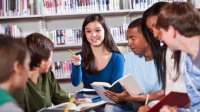Guiding Students to Develop Multimodal Literacy
Teachers can offer a variety of literacy-focused projects that allow students to display their critical thinking skills in creative ways.
Your content has been saved!
Go to My Saved Content.Anyone who has worked with striving readers or has spent time working through the reading process knows that literacy is a complex network of skills. At one time, being a literate person was a mark of power and status, and access to reading, writing, and creating was exclusive.
With links to a wealth of stories and ways of communicating through digital technology, what does reading mean now? In today’s world, being a literate person encompasses traditional texts (e.g., novels, short stories), as well as digital and app-based navigation. Traditional texts and digital/app-based navigation require many of the same skills.
Reading across multiple spaces is important for literacy. The multiple ways in which people communicate (modes) open up engagement opportunities for students—who might be ready for a new way to share or might benefit from having a new mode for presenting their work.
Reading with Visuals
Sometimes a student will search for the best word or phrase to sum up their feelings and ask, “What’s that word for?” At other times in a classroom discussion or writing, I can see a student looking for ways to share something that’s on their mind. Reading is a complex process in part because of the multiple steps that are involved, but the invisible nature of reading (the absence of images) adds to this complication.
By including visuals with reading, students who may have trouble finding the best words can be invited to share their thoughts. However, visuals aren’t just about limitations to literacy. In fact, the complex work of reading with visuals can be used to extend thinking and criticality for advanced readers. Expressing an idea in an illustrated sequential format, like the kind seen in comics, can add a new challenge for students who write and express ideas in more concrete patterns.
In my work with students, I find that the exercise of closely reading images can be paired up with making annotations for mentor texts. When I teach about culture, for example, one of the first texts I share with students is The Arrival, by Shaun Tan, to think about the emotions of an immigrant or refugee experience. Reading, in my practice, always leads to responding and creating, with the opportunity for students to compose multimodal memoirs as a next step.
The Role of Media
In our hyperlinked world of media consumption, however, static images and paper-based creations aren’t the only spaces or ways of responding. I recently had a student with an affinity for digital creation engage in a choice reading (Incarceron, by Catherine Fisher) and create an animated visual in response, capturing a scene. Glowing lights wobbled from side to side above the drawn image of a character resting in the context of a setting. I watched as the student composed this response across a few days, first sketching, then creating digital images, and then adding animation features.
The nature of the animation project is process-oriented and closely aligns with the idea of writing essays. Unlike most writing assignments, this project didn’t lock the student into a particular way of working. When engaged with a school beautification project a few days later, the student sketched ideas in digital form before creating a final product with paper-based tools.
In another instance, a student who was engaged with a choice reading from the realistic crime genre (The Butcher and the Wren, by Alaina Urquhart) created a podcast response. While technology is often policed in school spaces, there are also many affordances for bringing in devices with access to the internet and digital creation tools. In an effort to utilize social media for positive work, I point students to social activism examples online (for example, the artwork that was created in October 2022 surrounding women’s rights in Iran) and note the ways that authors engage on social media in sharing content and ideas.
Additionally, for students who lack fine motor skills or who want to engage with digital tools, projects like these are ideal. The role of assistive technology in literacy should never be underestimated or overlooked.
Linking Information and Critical Reading
Finally, I find multimodal design to be helpful when thinking about standards that are particularly tricky. Much of my work with students, as a high school English teacher, is focused on close reading and critical thinking. Informational text is an area for continuous growth and improvement, and I attempt to locate and share multiple examples of informational texts (such as Kelly Gallagher’s Article of the Week and CommonLit resources) throughout the school year.
In order to expand on what is possible with sharing information, and as a way of giving students multiple modes for engaging short research assignments, I ask students to participate in guided web-based exploring, culminating in making infographics. I show multiple examples related to historical events, like the Partition of India, and ask students to gather information and then share it visually and verbally. I have used this strategy as a way of inviting response to a particular shared text, as well as with choice readings.
This approach helps students envision information not simply as a lengthy research exercise but also as a way of communicating meaning with purpose. To engage with students in detailed ways, I’ve found that a generally designed rubric, which allows creative flow across ways of making or communicating, can be helpful.
Creating multimodally can be both invitational and challenging as students engage with new tools and processes. Design is part of critical thinking, as is the choice to share a message a particular way. Simply put, this kind of reading and composing fits well in the context of how students practice literacy in today’s world. Teachers are incredibly inventive people, and literacy is vital.
